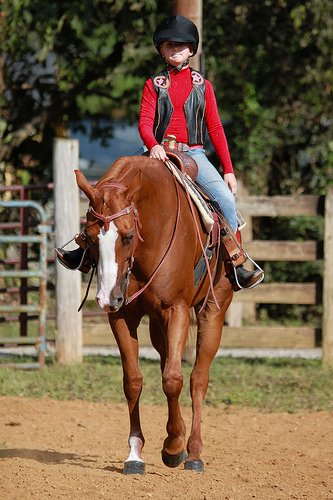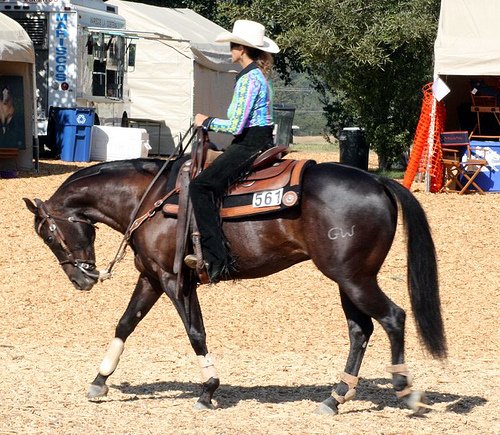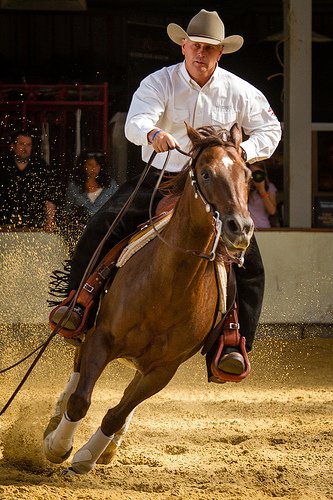
For some riders, getting that collected western trot and a forward walk that doesn’t look like the horse is wading through molasses is a constant battle. I have found that there is one exercise that best accomplishes both effectively; walk trot transitions. I’m not talking about throwing in a transition every few minutes, I mean rapid-fire transitions every 3 strides.
Prerequisites for transitions
- Softness through the poll and body
- Straightness through the body
- The beginnings of collection at the walk and trot
- Enough core muscle for both horse and rider so neither loses their form through the transitions
- Horse needs to be work off of body and seat cues
Teaching transitions
This can be done in an arena or out on a nice straight field lane. As I don’t have an arena a do the latter. I usually do this at a sitting trot, but it can be done at a posting trot too.
It is pretty simple once you get the hang of it. Start at a walk. To begin with, transition every 6 strides.
Count out loud: 1 – 2 – 3 – by 4 you should be setting up for the transition – by 5 you should start cuing the transition so that you finish the cue by 6. Rinse and repeat.
A huge thing to bare in mine is that – to begin with – the transitions will be very ugly. I don’t care how good of a rider you are, a horse who is not used to this – especially a lazy horse – is going to take issue with the amount of work this drill takes. I recommend carrying a dressage whip. I do not recommend spurs though unless you have excellent leg control and lots of experience using them because this drill is brutal and your legs will tire out fast.
This drill is 100% stolen from classical dressage, but it does wonders for every horse in any discipline. I use this after I have introduced collection at the walk and trot. The walk is the only gait without a moment of suspension, so it will either be the easiest gait to achieve collection in or the hardest.
For a horse with a slow walk
For a horse with a super slow walk, it will be the hardest gait to achieve collection in because good collection requires forward momentum. In this case, it is easiest to move on to the trot as horses with a slow walk will often have a decently forward trot. After a few lessons of collection at the trot and once the horse gets the hang of being on the bit – not necessary perfect, but understanding the concept – it is time to move on to transitions.
For a horse with a forward walk
If your horse has a forward walk, I would start the collection at the walk. Get the horse understanding the concept of being on the bit – again, not perfect, but understanding the concept – then work on the concept at a trot for a few lessons before moving onto transitions.
How does this slow down the trot and speed up the walk?
As your horse learns the drill, he will begin to anticipate the transitions. This drill actually takes advantage of that anticipation. Every time he goes up into a trot, he will immediately prepare to transition back down to a walk and as soon as he enters the walk he will know he only has a stride or two until he needs to trot again. He will quickly stop rushing through the trot and being so sluggish in the walk. Lifting his back through all those transitions will build a lot of topline and help him collect.
Troubleshooting
This is a really good drill for continuing to build topline. The horse should already have enough topline built that he shouldn’t be dropping his back too much through the transitions. If he starts getting sloppy enough that he’s dropping his back, you’ve pushed too far and need to slow down.
Perseverance
Do not get discouraged if things get worse before they get better. You need to gradually build your horse (and yourself) up with this drill, but you will be amazed at the results. Eventually, you should be able to change every 3 strides with little to no visible cues, but that takes many grueling hours of practice. The nice thing about this drill is you can do it just about anywhere. If you just do it in circles in the arena all day, your horse will get sour real fast. With my mare Moose, I always incorporate this drill on trail rides and anywhere we are riding. She never knows when or where it’s going to be thrown at her.
Anticipation
If the horse begins to anticipate too much, vary the amount of strides between transitions. Go from 3 to 5 to 4 to 3 to 6 and so on. Make it random. Sometimes repeat and sometimes don’t. Never do what you feel your horse is anticipating to do. If your horse anticipates 3 strides, push for 4, and so on. This way the drill will also help your horse focus on your cues and pay attention.
[bctt tweet=”The key to 1 fabulous transition is 1,000 awful transitions.” username=”EW_Blog”]
Practice Practice Practice
You cannot expect your horse to be perfect when you first start. I hear too many people complain about their horse’s transitions and then when they are asked how much they practice transition, their answer is: “I don’t because he’s bad at them and I don’t want him to learn them wrong.” You horse won’t get better without practice. You won’t get better without practice either.
Photo by Katherine Mustafa Photography









